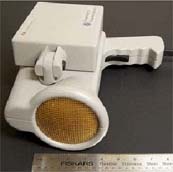 (November 2007) Want a device to see through walls, wood, concrete, earth, and steel? Scientists working for the DHS Science and Technology (S&T) Directorate looked around and found that nature sometimes comes in mighty handy.
(November 2007) Want a device to see through walls, wood, concrete, earth, and steel? Scientists working for the DHS Science and Technology (S&T) Directorate looked around and found that nature sometimes comes in mighty handy.
Take the lobster.
Here you have a crustacean with an amazingly miniscule brain, yet this creature is able to “see” through walls of dense water obscured by silt and sand to find its food buried deep along the ocean bottom. Lobsters have limited image resolution, but possess high sensitivity and the ability to detect fast movement and the polarization of light. Over eons, this bottom crawler developed compound eyes to view its world through a large number of long, narrow square-shaped cells, arranged in a spherical array with a 180° field of view. Any light the lobster takes advantage of down there is reflected from very highly reflective walls of the cells over a wide range of angles of incidence to form a fast focus. Each cell captures that small amount of light, which then enters the lobster’s eye from all angles. The light from these cells is then focused to form a single, intensified image.
This is some eye-opening stuff.
The eye that the S&T Directorate is building is almost as good as a lobster’s. And while it doesn’t exactly look and work like the eye of a lobster, this new handheld, through-the-wall “lobster eye x-ray imaging device” (LEXID) can detect and identify humans and contraband in hidden compartments and through walls of various thicknesses and material.
“LEXID is still very developmental, but it has some tremendous potential,” says Jim Apple of Physical Optics Corporation of Torrance, CA, which built the technology under a Small Business Innovation Research (SBIR) grant.
The Directorate has some tough specifications for this device. It must be able to “see” behind ship bulkheads, through several inches of soil, through steel, through wood beams, and through concrete. And, it must do this from about 9 feet away—a considerable distance that calls for the device to pack a hefty amount of power.
LEXID has sparked interest from the U.S. Coast Guard and U.S. Customs and Border Protection. Charged with knowing and scrutinizing what is coming into the country by land and by sea, both agencies are hard pressed when inspecting all the goods and vehicles that cross our borders—everything from cars to ships to cargo containers. The Transportation Security Administration has also expressed an interest in LEXID, particularly for its ability to see into wooden crates and cardboard containers, which make up many air cargo containers.
“In the wake of the 9/11 attacks, tools to inspect hidden or closed compartments for contraband or security threats was a need specifically identified and conveyed to us,” says Gerry Kirwin, who manages the project for the S&T Directorate.
“Who’d have known we’d get our inspiration from lobsters?” adds Kirwin.
To request more information about this story, please e-mail st.snapshots@hq.dhs.gov.
